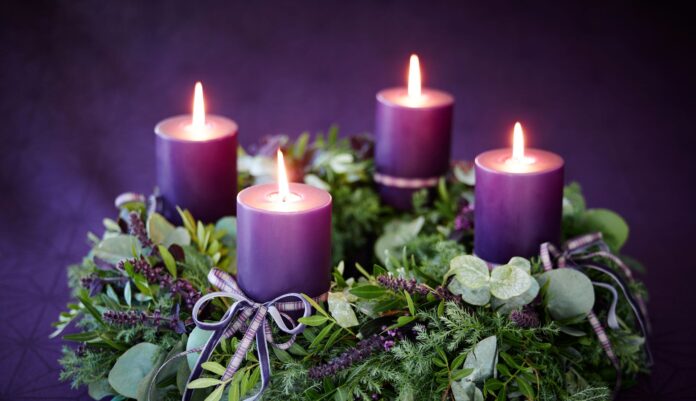
The word “Advent” comes from the Latin word “adventus,” which means “a coming, approach, arrival”, and is the name of the liturgical season – the four weeks before the celebration of the birth of Jesus Christ. Advent wreaths and candles are commonly seen in Catholic churches during the liturgical season. Many people also display Advent wreaths in their homes and light a candle each Sunday as families.
The origin of the Advent wreath has been traced back to Germany, though the exact dates are unknown. Historians have suggested that pre-Christian Germanic peoples would light evergreen wreaths in the dark winter months in anticipation of the return of the sun and warmer, brighter months in springtime.
This tradition likely evolved into an “Advent wreath” at some point during the Middle Ages, transforming the pagan tradition into a Christian one. One source says that an Advent wreath was first used in the 19th century in Hamburg, Germany. Lutheran pastor and teacher Johann Heinrich Wichern was the director of an orphanage and would gather the children for prayer and hymn-singing every evening during Advent. To brighten up the ritual, he decided to light a cangle each night setting them on a wooden wheel. Over time, children began decorating the wheel with evergreen twigs. Thus the tradition began with 24 candles, which were later reduced to four, and spread throughout Hamburg and then the rest of Europe, with one candle being lit every Sunday during Advent.
Since ancient times, the circular shape of the wreath itself has been a symbol of unity, infinity, the sun and its return. In the Christian era it bagan to symbolize Christ, the mystery of his unification with humankind. The wreath also represents the ring as symbol of fidelitiy. The evergreens used to decorate the Advent wreath symbolize the hope of eternal life, as well as referring to the palms laid before Christ as he entered Jerusalem.
There are various Advent wreath traditions in Europe. In England, one wreath is hung on the entrance door, and another decorates the dining room. In Denmark the wreath is made of spruce twigs and decorated with white candles and red fruit, usually apples. In England red candles are used, representing the joy of awaiting the Messiah. In Germany the wreath is embellished with Christmas tree decorations.
The four candles of Advent represent the four Sundays of Advent, and they respectively symbolize hope, peace, joy, and love. In some homes and parishes, people will also light a fifth candle on Christmas Eve or Christmas Day to represent the birth of Jesus; this candle, when added to the Advent wreath, is typically white and larger than the other candles and is placed in the center of the wreath. It represents the innocence of Mary, the mother of Christ.
Catholics traditionally use three purple candles and one pink candle for the Advent wreath. Purple is the liturgical colour for the Advent season, and represents penance, meditation and solemnity. The first candle on the Advent wreath is called the candle of Prophecy and represents hope in anticipation of the birth of Christ and to celebrate the beginning of a new liturgical season. Often called the “Bethlehem Candle,” the second Advent candle reminds us of Mary and Joseph’s journey from Nazareth to Bethlehem and represents Peace. The pink candle, representing the waiting shepherds’ joy is lit on the third Sunday of Advent, which is called Gaudete Sunday. The fourth candle of Advent represents Love, and is called the “Angel’s Candle,” and is again, purple.
Creating an Advent wreath is a simple and positive way to engage children in the family, to bring meaning to the season and enjoy a quieter aspect of preparing for Christmas.





























